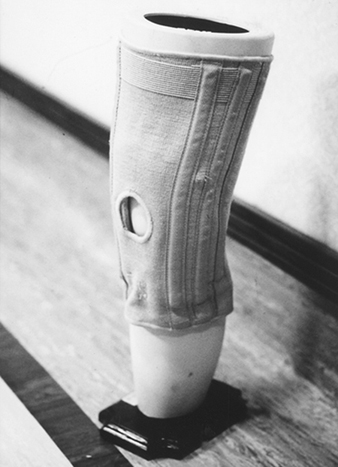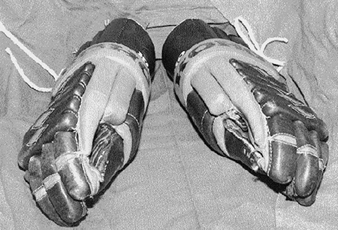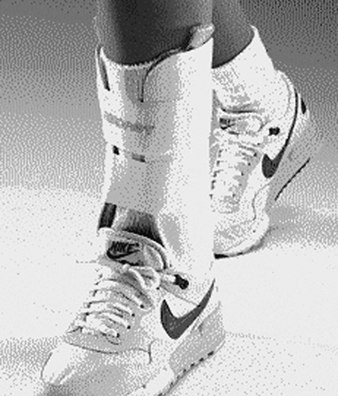Sports activities involve a great number of injuries. Precautions, conditioning and safety equipment, when used properly, will minimize sports injuries.
In all sports, conditioning year round is encouraged. Bone, ligaments and muscles respond in a physiological fashion by gaining both size and strength (Clare 1990). This increases the athlete’s agility to avoid any injurious physical contact. All sports requiring weightlifting and strengthening should be under the supervision of a strength coach.
Contact Sports
Contact sports such as American football and hockey are particularly dangerous. The aggressive nature of football requires the player to strike or tackle the opposing player. The focus of the game is to possess the ball with the intent of physically striking anyone in one’s path. The equipment should be well-fitting and offer adequate protection. (figure 1). The helmet with appropriate face mask is standard and is critical in this sport (figure 2). It should not slide or twist and the straps should be applied snugly (American Academy of Orthopedic Surgeons 1991).
Figure 1. Snug fitting football pads.
MISSING
Source: American Academy of Orthopedic Surgeons 1991
Figure 2. American football helmet.
MISSING
Source: Clare 1990
Unfortunately, the helmet is sometimes used in an unsafe manner whereby the player “spears” an opponent. This can lead to cervical spine injuries and possible paralysis. It can also lead to careless play in sports like hockey, when players feel they can be more free with the use of their stick and risk slashing the face and body of the opponent.
Knee injuries are quite common in football and basketball. In minor injuries, an elastic “sleeve” (figure 3) which provides compressive support may be useful. The ligaments and cartilage of the knee are prone to stress as well as impact trauma. The classic combination of cartilage and ligamentous insult was first described by O’Donoghue (1950). An audible “pop” may be heard and felt, followed by swelling, if there are ligament injuries. Surgical intervention may be needed before the player may resume activities. A derotational brace may be worn post-operatively and by players with partial tear of the anterior cruciate ligament but with enough intact fibres able to sustain their activities. These braces must be well padded to protect the injured extremity and other players (Sachare 1994a).
Figure 3. Patella cut-out sleeve.
Huie, Bruno and Norman Scott
In hockey, the velocity of both the players and the hard hockey puck warrants the use of protective padding and helmet (figure 4). The helmet should have a face shield to prevent facial and dental injuries. Even with helmets and protective padding to vital areas, severe injuries such as fractures of extremities and spine do occur in football and hockey.
Figure 4. Padded hockey gloves.
Huie, Bruno and Norman Scott
In both American football and hockey, a complete medical kit (which includes diagnostic instruments, resuscitation equipment, immobilization devices, medication, wound care supplies, spine board and stretcher) and emergency personnel should be available (Huie and Hershman 1994). If possible, all contact sports should have this available. Radiographs should be obtained of all injuries to rule out any fractures. Magnetic resonance imaging has been found to be very helpful in determining soft tissue injuries.
Basketball
Basketball is also a contact sport, but protective equipment is not worn. The focus of the player is to have possession of the ball and their intent is not to strike the opposing players. Injuries are minimized due to the player’s conditioning and speed in averting any hard contact.
The most common injury to the basketball player are ankle sprains. Evidence of ankle sprains has been noted in about 45% of players (Garrick 1977; Huie and Scott 1995). The ligaments involved are the deltoid ligament medially and the anterior talofibular, posterior talofibular, and calcaneofibular ligaments laterally. X rays should be obtained to rule out any fractures which may occur. These radiographs should include the entire lower leg to rule out a Maisonneuve fracture (VanderGriend, Savoie and Hughes 1991). In the chronically sprained ankle, use of a semi-rigid ankle stirrup will minimize further insult to the ligaments (figure 5).
Figure 5. Rigid ankle stirrup.
AirCast
Finger injuries may result in ruptures of the supporting ligamentous structures. This can result in a Mallet finger, Swann Neck deformity and Boutonierre deformity (Bruno, Scott and Huie 1995). These injuries are quite common and are due to direct trauma with the ball, other players and the backboard or rim. Prophylactic taping of ankles and fingers helps minimize any accidental twisting and hyperextension of the joints.
Facial injuries (lacerations) and fractures of the nose due to contact with opponents’ flailing arms or bony prominences, and contact with the floor or other stationary structures have been encountered. A clear light-weight protective mask may help in minimizing this type of injury.
Baseball
Baseballs are extremely hard projectiles. The player must always be cognizant of the ball not only for safety reasons but for the strategy of the game itself. Batting helmets for the offensive player, and chest protector and catcher’s mask/helmet (figure 6). for the defensive player are required protective equipment. The ball is hurled at times in excess of 95 mph, sometimes resulting in bone fractures. Any head injuries should have a full neurological work-up, and, if loss of consciousness is present, radiographs of the head should be taken.
Figure 6. Protective cather's mask.
MISSING
Huie, Bruno and Norman Scott
Soccer
Soccer can be a contact sport resulting in trauma to the lower extremity. Ankle injuries are very common. The protection that would minimize this would be taping and the use of a semi-rigid ankle stirrup. It has been found that the effectiveness of the taped ankle diminishes after about 30 minutes of vigorous activities. Tears of the anterior cruciate ligament of the knee are often encountered and most likely will require a reconstructive procedure if the player wishes to continue participating in this sport. Anterior medial tibial stress syndrome (shin splints) is extremely common. The hypothesis is that there may be an inflammation to the periosteal sleeve around the tibia. In extreme situations, a stress fracture may occur. The treatment requires rest for 3 to 6 weeks and the use of non-steroidal anti-inflammatory drugs (NSAID), but high-level and professional-level players tend to compromise the treatment once the symptoms diminish as early as 1 week and thus go back to the impact activity. Hamstring pulls and groin pulls are common in the athletes who do not permit enough time to warm and stretch the musculature of the legs. Direct trauma to the lower extremities, particularly the tibia, may be minimized with the use of anterior shin guards.
Skiing
Skiing as a sport does not require any protective equipment, although goggles are encouraged to prevent eye injuries and to filter out the sun’s glare off the snow. Ski boots offer a rigid support for the ankles and have a “quick-release” mechanism in the event of a fall. These mechanisms, although helpful, are susceptible to circumstances of the fall. During the winter season, many injuries to the knee resulting in ligament and cartilage damage are encountered. This is found in the novice as well as the seasoned skier. In professional downhill skiing, helmets are required to protect the head due to the velocity of the athlete and the difficulty of stopping in the event the trajectory and direction are miscalculated.
Martial Arts and Boxing
Martial arts and boxing are hard contact sports, with little or no protective equipment. The gloves used on the professional boxing level are, however, weighted, which increases their effectiveness. Head guards at the amateur level help soften the impact of the blow. As with skiing, conditioning is extremely important. Agility, speed and strength minimize the combatant’s injuries. The blocking forces are deflected more than absorbed. Fractures and soft tissue insults are very common in this sport. Similar to volleyball, the repetitive trauma to the fingers and carpal bones of the hand results in fractures, subluxation, dislocation and ligamentous disruptions. Taping and padding of the hand and wrist may provide some support and protection, but this is minimal. Studies have shown that long-term brain damage is a serious concern for boxers (Council on Scientific Affairs of the American Medical Association 1983). Half of a group of professional boxers with more than 200 fights each had neurological signs consistent with traumatic encephalopathy.
Horse Racing
Horse racing at the professional and amateur levels requires a riding helmet. These helmets offer some protection for head injuries from falls, but they offer no attachment for the neck or spine. Experience and common sense help minimize falls, but even seasoned riders can sustain serious injuries and possibly paralysis if they land on their head. Many jockeys today also wear protective vests since being trampled under horses’ hooves is a major risk in falls and has resulted in fatalities. In harness racing, where horses pull two-wheeled carts called sulkies, collisions between sulkies has resulted in multiple pile-ups and serious injuries. For hazards to stable hands and others involved in handling the horses, see the chapter Livestock rearing.
First Aid
As a general rule, immediate icing (figure 7), compression, elevation and NSAIDs following most injuries will suffice. Pressure dressings should be applied to any open wounds, followed by an evaluation and suturing. The player should be removed from the game immediately to prevent any blood-borne contamination to other players (Sachare 1994b). Any head trauma with loss of consciousness should have a mental status and neurological work-up.
Figure 7. Cold compressive therapy.
MISSING
AirCast
Physical Fitness
Professional athletes with asymptomatic or symptomatic cardiac conditions may be hesitant in disclosing their pathology. In recent years, several professional athletes have been found to have cardiac problems that resulted in their deaths. The economic incentives of playing professional-level sports may inhibit athletes from disclosing their conditions for fear of disqualifying themselves from strenuous activities. Carefully obtained past medical and family histories followed by EKG and treadmill stress tests prove to be valuable in detecting those who are at risk. If a player is identified as a risk and still wishes to continue competing regardless of the medical-legal issues, emergency resuscitative equipment and trained personnel must be present at all practices and games.
Referees are present not only to keep the flow of the game going but to protect the players from hurting themselves and others. Referees, for the most part, are objective and have the authority to suspend any activity should an emergency condition arise. As with all competitive sports, emotion and adrenaline are flowing high; the referees are present to help the players harness these energies in a positive fashion.
Proper conditioning, warm-up and stretching prior to engaging in any competitive activity is vital to the prevention of strains and sprains. This procedure enables the muscles to perform at peak efficiency and minimizes the possibilities of strains and sprains (micro-tears). Warm-ups may very well be a simple jog or callisthenics for about 3 to 5 minutes followed by gentle stretching out of the extremities for an additional 5 to 10 minutes. With the muscle at its peak efficiency, the athlete may be able to quickly manoeuvre away from a threatening position.



